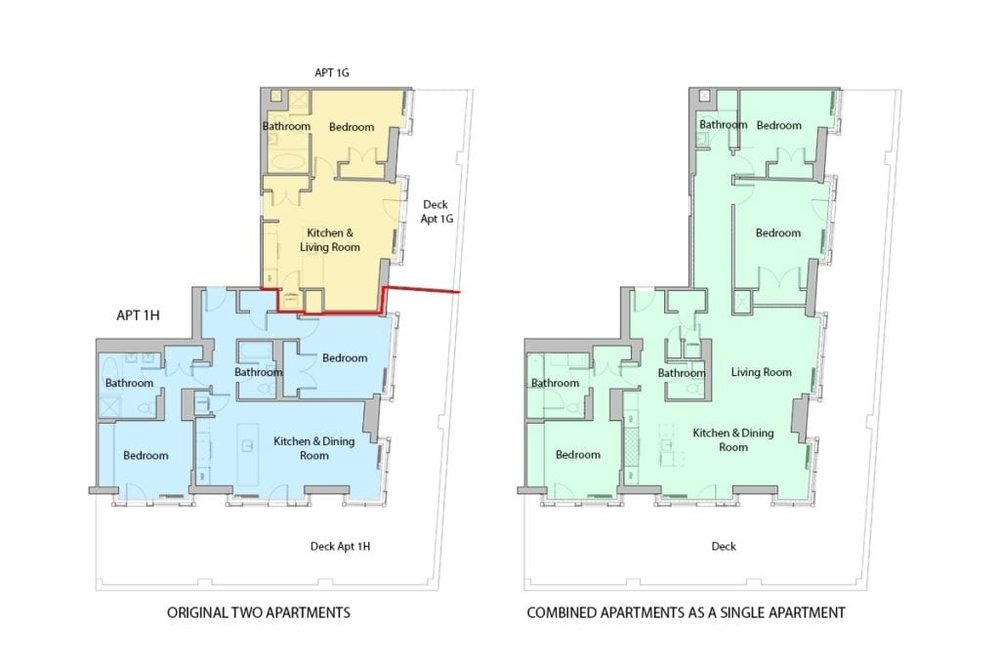COMBINED APARTMENTS CAN BE THE SINGLE BEST THING
Have you ever believed 1+2= 2.5? Data guru Jonathan Miller, who goes by the data brand Miller Samuels does! The wholesale pricing of today’s new developments doesn’t exist. In fact developers and their sales agents are creating inflated demand as they hold back inventory all the while letting press releases loose on the off market sales of the building taking place. Buyer’s don’t know what is true and what is a bluff any more.
One nifty trait what comes with buying new construction is negotiating wholesale prices on adjacent units to eventually make yourself a combo unit. A one bedroom next to another one bedroom, buy both conjoin, and immediately increase the resale value of the spaces you own. By seeing these opportunities, you should understand that your monthly carrying costs will be combined between both units, naturally combining tax lots and property lots.
If the opportunity should arise for you to buy the next door unit, you should be aware of a couple of things:
1) Your building may require you to combine the units within a certain time frame. If a co-op, some co-ops even require you to submit plans for joining units simultaneously with your purchase application.
2) If your financing the purchase of an adjacent unit, you should ask your broker to recommend a lender who will be able to lend a unit product type that allows you to own both units. Once conjoined, it’s common to refinance both units ( hopefully rates are still low) and take out one new mortgage against the appraised value of the connected new home.
3) You should crunch the numbers and understand how much work the unit will really entail. A broker can help you estimate the resale value once completed.
The “value premium”, as Miller Samuels quoted, varies widely based on the size and configurations of the apartments. This premium doesn’t apply to all combos but since there is a Manhattan premium for larger contiguous space. Some have even found that , Once the total size approaches 7,000 square feet, there is no premium, and in fact, the impact on a price per square foot basis often falls.” Those luxury apartments or townhouses are always valued in markets of their own.
In Jonathan Miller's words, these are the issues and observations with combos:
There is generally a premium enjoyed by acquiring the neighbor’s apartment, even before they are combined.
Usually, the larger apartment owner is acquiring the smaller apartment (say a 3-bedroom owner’s purchase of a studio) and therefore it is likely they will need to significantly overpay for the studio. But the premium enjoyed afterward can make that a no-brainer.
Co-ops tend to leave the building Certificate of Occupancy alone with the idea that if the market softens or the owner falls on bad times, they can easily sell off the smaller apartment.
We often perform three valuation opinions to lenders: “as is” appraisal of each apartment and a “subject to combination and renovation” of both apartments” value. In the early 90s we ran across a few fraud scenarios where one bank held the mortgage of each of the individual apartments and a second bank held the combined mortgage for both apartments. I never understood how that could have happened in a co-op.
Often in a combo scenario, additional common hallway area is purchased from the co-op to make the layout better.
I believe the goal of the combined layout is to provide something that doesn’t “feel” like a combination of two or more apartments. That’s hard to do.
The above is cited and quoted from the original article : Miller Samuels Combo Units Dec 2018
The New York Times Real Estate Section cover story “Hey Neighbor, Can I Buy Your Apartment?“ covers how timing a next door purchase could take years. Upon finally securing your neighbor’s apartment, going through the alteration submission process by the building’s board and building management is the next feat. Expect to wait up to 2-5 months to commence construction, and another 3 months to complete and properly file for the alterations made with the DOB. A good broker, who is keen on alteration investigation work will follow Building Department Plans to best advise on the Architect, Contractor, and Inspector of the work was.
As per the NYC Department of Buildings, combining a unit or creating additional bedrooms in a floor plan requires legally filing for a updated Certificate of Occupancy.
An except taken from NYC’s Combining Apartments Alteration Application states,
“Plan examination by the Department and completion sign-off by a Professional Engineer or Registered Architect shall be limited to the apartments being altered Upon sign-off of the completed work, the Borough Office shall issue a letter of completion. The letter of completion issued shall clearly state at the end, "The Department of Buildings does not require a new or amended certificate of occupancy for combining these apartments."
If you’re looking to start the hunt for combo units, whether construction or existing, reach out to learn more.

